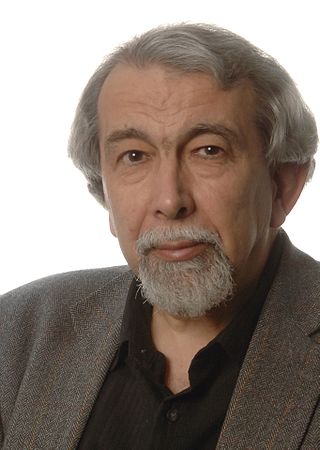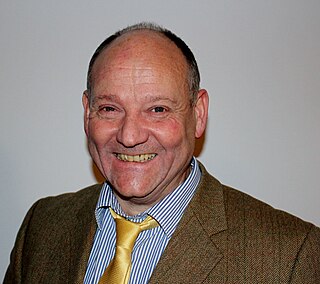
Endocrinology is a branch of biology and medicine dealing with the endocrine system, its diseases, and its specific secretions known as hormones. It is also concerned with the integration of developmental events proliferation, growth, and differentiation, and the psychological or behavioral activities of metabolism, growth and development, tissue function, sleep, digestion, respiration, excretion, mood, stress, lactation, movement, reproduction, and sensory perception caused by hormones. Specializations include behavioral endocrinology and comparative endocrinology.
Ronald Mark Evans is an American Biologist, Professor and Head of the Salk’s Gene Expression Laboratory, and the March of Dimes Chair in Molecular and Developmental Biology at the Salk Institute for Biological Studies in La Jolla, California and a Howard Hughes Medical Institute Investigator. Dr. Ronald M. Evans is known for his original discoveries of nuclear hormone receptors (NR), a special class of transcriptional factor, and the elucidation of their universal mechanism of action, a process that governs how lipophilic hormones and drugs regulate virtually every developmental and metabolic pathway in animals and humans. Nowadays, NRs are among the most widely investigated group of pharmaceutical targets in the world, already yielding benefits in drug discovery for cancer, muscular dystrophies, osteoporosis, type II diabetes, obesity, and cardiovascular diseases. His current research focuses on the function of nuclear hormone signaling and their function in metabolism and cancer.
Photoperiodism is the physiological reaction of organisms to the length of light or a dark period. It occurs in plants and animals. Plant photoperiodism can also be defined as the developmental responses of plants to the relative lengths of light and dark periods. They are classified under three groups according to the photoperiods: short-day plants, long-day plants, and day-neutral plants.

Michael James Benton is a British palaeontologist, and professor of vertebrate palaeontology in the School of Earth Sciences at the University of Bristol. His published work has mostly concentrated on the evolution of Triassic reptiles but he has also worked on extinction events and faunal changes in the fossil record.

Sir Thomas Leon Blundell, is a British biochemist, structural biologist, and science administrator. He was a member of the team of Dorothy Hodgkin that solved in 1969 the first structure of a protein hormone, insulin. Blundell has made contributions to the structural biology of polypeptide hormones, growth factors, receptor activation, signal transduction, and DNA double-strand break repair, subjects important in cancer, tuberculosis, and familial diseases. He has developed software for protein modelling and understanding the effects of mutations on protein function, leading to new approaches to structure-guided and Fragment-based lead discovery. In 1999 he co-founded the oncology company Astex Therapeutics, which has moved ten drugs into clinical trials. Blundell has played central roles in restructuring British research councils and, as President of the UK Science Council, in developing professionalism in the practice of science.
Erwin Bünning was a German biologist. His most famous contributions were to the field of chronobiology, where he proposed a model for the endogenous circadian rhythms governing plant photoperiodism. From these contributions, Bünning is considered a co-founder of chronobiology along with Jürgen Aschoff and Colin Pittendrigh.

The Japanese quail, also known as the coturnix quail, is a species of Old World quail found in East Asia. First considered a subspecies of the common quail, it is now considered as a separate species. The Japanese quail has played an active role in the lives of humanity since the 12th century, and continues to play major roles in industry and scientific research. Where it is found, the species is abundant across most of its range. Currently, there are a few true breeding mutations of the Japanese quail. The varieties currently found in the United States include Pharaoh, Italian, Manchurian, Tibetan, Rosetta, along with the following mutations: sex-linked brown, fee, roux, silver, andalusian, blue/blau, white winged pied, progressive pied, albino, calico, sparkly, as well as non-color mutations such as celadon.

Sir Howard Dalton, FRS was a British microbiologist. He served as the Chief Scientific Advisor to the UK's Department for Environment, Food and Rural Affairs (DEFRA) from March 2002 to September 2007.
Peter C. Whybrow is an English psychiatrist and award-winning author whose primary research focus has been on understanding the metabolic role of thyroid hormones in the adult brain and how to apply this knowledge to the treatment of mood disorder, especially bipolar disorder. He is Judson Braun Distinguished Professor in the Department of Psychiatry and Biobehavioral Sciences of the David Geffen School of Medicine at UCLA.

Russell Grant Foster, CBE, FRS FMedSci is a British professor of circadian neuroscience, the Director of the Nuffield Laboratory of Ophthalmology and the Head of the Sleep and Circadian Neuroscience Institute (SCNi). He is also a Nicholas Kurti Senior Fellow at Brasenose College at the University of Oxford. Foster and his group are credited with key contributions to the discovery of the non-rod, non-cone, photosensitive retinal ganglion cells (pRGCs) in the mammalian retina which provide input to the circadian rhythm system. He has written and co-authored over a hundred scientific publications.
Hon. Richard Tedder FRCP is an English virologist and microbiologist, was head of the Department of Virology at the University College London Medical School, and worked as virologist at Public Health England
Colin Stephenson Pittendrigh was a British-born biologist who spent most of his adult life in the United States. Pittendrigh is regarded as the "father of the biological clock," and founded the modern field of chronobiology alongside Jürgen Aschoff and Erwin Bünning. He is known for his careful descriptions of the properties of the circadian clock in Drosophila and other species, and providing the first formal models of how circadian rhythms entrain (synchronize) to local light-dark cycles.
Annabelle "Anna" Frances Glasier OBE, FFSRH, FRCOG FRSE is an English physician in the field of reproductive medicine. Glasier is a world expert on emergency contraception, and her work has been instrumental in making it available in the UK and other countries without medical prescription
The Wolfson Research Exchange is a research facility for doctoral and postdoctoral researchers at the University of Warwick.

The UCL Division of Psychology and Language Sciences is a Division within the Faculty of Brain Sciences of University College London (UCL) and is located in London, United Kingdom. The Division offers teaching and training and undertakes research in psychology and communication and allied clinical and basic science. It is the largest university psychology department in England.

Patrick Gerald McKenna, DL, FIBMS, FRSB, MRIA, known informally and widely as Gerry McKenna, is a Chartered Biologist and Chartered Scientist from Northern Ireland.
Gonadotropin-inhibitory hormone (GnIH) is a RFamide-related peptide coded by the NPVF gene in mammals.

Michael Harvey Hastings is a British neuroscientist who works at the Medical Research Council MRC Laboratory of Molecular Biology (LMB) in Cambridge, UK. Hastings is known for his contributions to the current understanding of biological clocks in mammals and marine invertebrates.
Laura Elizabeth Green is a British epidemiologist and academic who is Pro-vice-chancellor and Head of the College of Life and Environmental Sciences at the University of Birmingham. She serves on the council of the Biotechnology and Biological Sciences Research Council (BBSRC).
Randy J. Nelson is an American neuroscientist who holds the Hazel Ruby McQuain Chair for Neurological Research and the founding chair of the Department of Neuroscience at the West Virginia University School of Medicine. Much of his research has focused on the contribution of circadian and seasonal rhythms on physiology and behavior.








